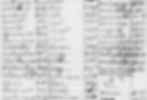This Day in History: Agent 355 & the Culper Spy Ring
- tara
- Oct 9, 2021
- 3 min read
Updated: May 5, 2024
On or around this day in 1780, a female agent in one of Washington’s spy rings may have been arrested. Can you believe that this woman was so good at hiding her identity that we *still* do not know who she was!? We can mostly just guess at what happened to her.
The mystery lady, a.k.a. Agent 355, was a member of the Culper Spy Ring, which operated in the New York area under the supervision of Benjamin Tallmadge. Other members included Abraham Woodhull (a.k.a. Samuel Culper, Sr.) and Robert Townsend (a.k.a. Samuel Culper, Jr.). They used business or family relationships in the area as cover for their activities.
The system used by the spy ring was perhaps a bit sophisticated for that time.

As Townsend collected information, he encoded it using a system of number sets that had been created by Tallmadge. These sets assigned numbers to 763 commonly used words, places, and people. If a word was needed outside of this set, then a mixed up alphabet was used to create it. Once created, the coded message was written in invisible ink, but a regular, mundane letter would be written on the same page, thus hiding the contents of any given secret message. At this point in the process, two other members of the ring got involved. A tavern keeper, Austin Roe, would take the letters to Woodhull, who passed them on to Caleb Brewster. Brewster delivered them to Tallmadge, who delivered them to Washington.
Some movements were made possible by Anna Strong, a signal woman who lived on Strong’s Neck, Long Island. She was able to use her laundry line to send coded messages. For instance, if she hung a certain type of shirt or petticoat on her line, combined with a certain number of handkerchiefs, that might indicate that Woodhull had information ready for Brewster to pick up.
It’s believed that the spy ring made significant contributions to the discovery of Benedict Arnold’s treachery.
Agent 355 got her name because “355” was the number assigned to the word “lady” in Tallmadge’s secret code. She was directly referenced one time in Woodhull’s correspondence. In August 1779, Woodhull wrote: “I intend to visit 727 [New York] before long and think by the assistance of a 355 [lady] of my acquaintance, shall be able to out wit them all.”
An October 1780 letter has led some historians to believe that Agent 355 was arrested at about that time. In that letter, Woodhull reported that “several friends” had been captured, including “one who hath been ever serviceable to this correspondence.” Reportedly, Townsend had an extreme reaction to the news, even stealing large sums of money at about this time. Was he emotionally attached to Agent 355? Was he trying to raise a ransom? Others go even further and say that Agent 355 was sent to a British prison ship. She had a baby (perhaps Townsend’s love child?) before she died aboard the ship.
Other historians, so you know, take a much more prosaic view. They state that the identity of Agent 355 is really not so complicated. She was Anna Smith Strong, the signal woman on Strong’s Neck. They dispute that a woman was ever aboard a British prison ship.
We may never know which perspective is correct. But the story is representative of something else that we **do** know: There were many unsung—even unidentified—heroes of the American Revolution. But for them, America might never have gained her freedom.
Primary Sources:
Alexander Rose, Washington’s Spies: The Story of America’s First Spy Ring (2006)
Carol Berkin, First Generations: Women in Colonial America (1996)
Lisa Tendrich Frank, An Encyclopedia of American Women at War: From the Home Front to the Battlefields (2013)
Ralph E Weber, Masked Dispatches: Cryptograms and Cryptology in American History, 1775-1900 (2012)
Thomas B. Allen, George Washington, Spymaster: How the Americans Outspied the British and Won the Revolutionary War (2004)


